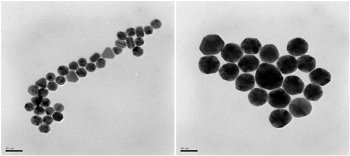The current body of literature in nano-toxicology and fundamental colloidal interaction is inadequate in systematically addressing the role of size, shape, and surface chemistry on aggregation properties and thereby on critically analyzing toxicity mechanisms. Most of the physico-chemical characterizations performed for toxicological interpretation are performed in clean aqueous systems and mostly at beginning and end of exposure time periods that are not representative of the actual exposure conditions and time periods. Preliminary studies performed using 30 and 60 nm diameter gold nanospheres at exposure media under physiological temperature (37 °C) have shown that interesting aggregation phenomena occur around 6 hr exposure time period (which is typically ignored in toxicity studies)—essentially nanoparticles lose their size identity and form networks of particles at and beyond such time points. This might have significant consequence in toxicity response of cells near such time periods and can lead to unexplored future research using such time considerations. Moreover, aggregate structure information is ignored in the current literature, which will not only cause particle settling in well-plate exposure studies but also can have significant impact on how cellular entities interact with fractal aggregates compared to dense aggregate structures. A fundamental diffusion-based model has been developed to investigate aggregation behavior of nanoparticles. This model will be further modified using equivalent volume technique to predict particle aggregate structure. The research effort that will be undertaken will primarily involve the following: aggregation kinetics and fractal dimension measurements as a function of particle size, shape, and structure, development of diffusion-based model to predict aggregation behavior.
Developing Predicting Capability for Nanoparticle Aggregation and Aggregate Structure Evolution in Biologically Relevant Systems

Additional Info
-
Funding Agency:
 US Air Force Research Laboratory (USAFRL), Wright Patterson Air Force Base
US Air Force Research Laboratory (USAFRL), Wright Patterson Air Force Base
- Award Amount: $60,000
- Investigators: PI-Navid Saleh, Civil and Env Eng, USC
- Project Period: October 15, 2011- October 14, 2012
Publications
- M. Schrand, A.M., Lin, J.B, Garrett, C. M, Brownheim, S.V., Afrooz, ARM N, Saleh, N., Hussain, M.S. "Dynasore Pretreatment Rescues Copper Nanoparticle Cytotoxicity", J Phys Chem Lett, 2011 (in review).
- Schaeublin, N M, Braydich-Stolle, L K, Park, K, MacCuspie, R I, Vaia, R A, Hussain, S M, "Gold Nanoparticle Shape Determines Stress Response in Human Skin Cells", Small, 2011 (in review).
- Garrett C. M., Schrand A. M., Afrooz, A R M. N., Braydich-Stolle, L K., Saleh, N. B., McDougal, J. N., Hussain, S. M. "Fractal Dimension of Gold Nanoparticle Aggregates Induced Differential Gene Expression", Small, 2011, (in review)
